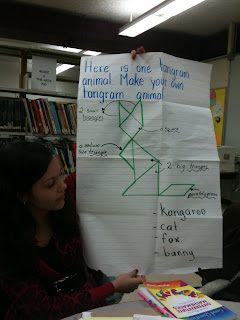

For the past two weeks I've been working with Savita who teaches a split Grade 3 /4 class. We have been focusing on measurement. Our lessons have been done through problem solving and have been very hands on for the students. In addition to using geoboards, we have also had the students use the computer and the Smart Board to help share their strategies.
Earlier this week her and I both had a huge "Ahh" moment when one of her students described (during the math congress) how she was sure we had found all of the possible rectangles. It was a real eye opener. Both Savita and I realized that had we not congressed, then this great insight would never have been shown to us or the rest of the class.
We had chosen a problem from the Math Makes Sense textbook and had done a KWC (Know, What the question is asking, and special Conditions) Chart to help students comprehend what the problem was asking. (See first picture)The problem that the students were working on was the following:
You want to make a rectangular garden with a perimeter of 24m. The garden must have the greatest possible area. What should the dimensions of the garden be?
The students had all worked on the possible perimeters and areas and several had choosen to share what their gardens would look like and what the dimensions would be. After we had a few responses the students were asked "Do we know which one has the greatest possible area?" and "Do we agree with it?" The children all agreed that they thought the 7m x 5m garden had the greatest area. When they were asked a third question of "How do you know" is where the conversation got intersting. (See second picture)
Some students said that they knew which one it was because it had the biggest area of all the gardens we had drawn. We then probed them with "Are you sure?" and in the crowd of nodds, one girl put up her hand and said:
I'm sure, because if you go to 6m x 6m then all you get is a square. And the conditions said that we had to have a rectangular garden. If you look at the numbers we have 11m x 1m, then 10m x 2 m.
At this point I prompted her more by asking her if there was a way we could write this out to prove that her answer was correct. The class came up with the idea of a chart and then we got to work making our chart and putting in the dimensions and the area. We also drew a 6m x 6m shape and got a square - just as predicted. The students then began to see a pattern between the dimensions. They also said that we didn't need to keep going because it didnt' matter which number came first because when we multiplied the two together we always got the same area.
Had we not taken the time to have the congress, we never would have known the deep level of understanding that this student had, or the connections to other mathematical concepts that the rest of the class was able to make. A huge lightbulb moment for all in the room.



